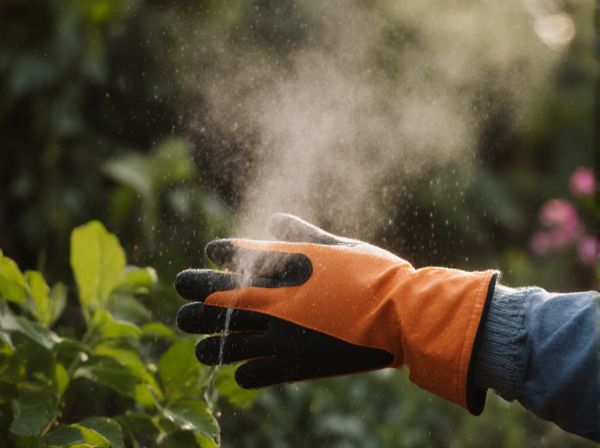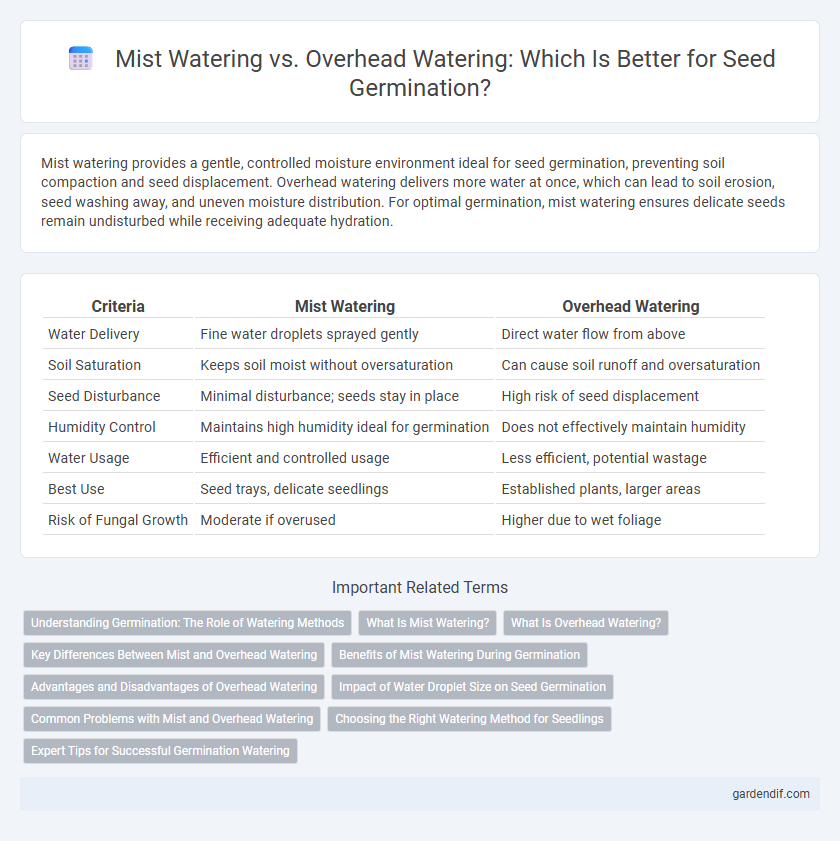
Mist Watering vs Overhead Watering Illustration
Mist watering provides a gentle, controlled moisture environment ideal for seed germination, preventing soil compaction and seed displacement. Overhead watering delivers more water at once, which can lead to soil erosion, seed washing away, and uneven moisture distribution. For optimal germination, mist watering ensures delicate seeds remain undisturbed while receiving adequate hydration.
Table of Comparison
| Criteria | Mist Watering | Overhead Watering |
|---|---|---|
| Water Delivery | Fine water droplets sprayed gently | Direct water flow from above |
| Soil Saturation | Keeps soil moist without oversaturation | Can cause soil runoff and oversaturation |
| Seed Disturbance | Minimal disturbance; seeds stay in place | High risk of seed displacement |
| Humidity Control | Maintains high humidity ideal for germination | Does not effectively maintain humidity |
| Water Usage | Efficient and controlled usage | Less efficient, potential wastage |
| Best Use | Seed trays, delicate seedlings | Established plants, larger areas |
| Risk of Fungal Growth | Moderate if overused | Higher due to wet foliage |
Understanding Germination: The Role of Watering Methods
Mist watering promotes gentle hydration essential for seed germination by maintaining consistent moisture levels without displacing seeds or causing soil compaction. Overhead watering can lead to uneven water distribution and increased risk of seed erosion, negatively impacting seedling emergence and root development. Effective germination depends on selecting watering methods that ensure optimal moisture retention and avoid physical disturbance to fragile seeds.
What Is Mist Watering?
Mist watering involves spraying a fine mist of water onto seeds or seedlings to maintain consistent moisture without causing soil erosion or seed displacement. This method ensures delicate roots receive adequate hydration while promoting optimal oxygen exchange, crucial for successful germination. Compared to overhead watering, mist watering reduces the risk of fungal diseases by minimizing water droplets on foliage.
What Is Overhead Watering?
Overhead watering involves applying water from above the plants using sprinklers or watering cans, mimicking natural rainfall. This method distributes water evenly over the soil surface and plant foliage, promoting uniform germination and growth. However, excessive overhead watering can increase the risk of fungal diseases by leaving leaves wet for prolonged periods.
Key Differences Between Mist and Overhead Watering
Mist watering delivers fine droplets directly to seedling surfaces, maintaining optimal moisture without waterlogging, which accelerates germination rates. Overhead watering distributes larger water volumes broadly, risking soil saturation and seed displacement, potentially hindering germination success. Efficient germination requires mist watering for controlled hydration, while overhead methods suit established plants demanding thorough irrigation.
Benefits of Mist Watering During Germination
Mist watering provides gentle, consistent moisture ideal for seed germination, preventing soil disruption and seed displacement that can occur with overhead watering. It maintains optimal humidity levels around seeds, promoting faster and more uniform sprout development. This method also reduces water wastage and minimizes the risk of fungal diseases by keeping leaves and soil surface damp without waterlogging.
Advantages and Disadvantages of Overhead Watering
Overhead watering provides even moisture distribution, promoting uniform germination across seedbeds and reducing soil compaction risk due to gentle water application. However, it can increase leaf wetness duration, heightening the possibility of fungal diseases and seedling damping-off, especially in high humidity environments. This method may also cause seed displacement or soil crusting if water pressure is too high or applied improperly.
Impact of Water Droplet Size on Seed Germination
Mist watering delivers fine water droplets that gently hydrate seeds without displacing soil or damaging delicate seed coats, promoting uniform germination. Overhead watering produces larger droplets that can create soil crusting and seed washaway, reducing oxygen availability and increasing germination failure rates. Optimizing water droplet size through mist irrigation enhances seed-soil contact and moisture retention, critical factors in successful germination.
Common Problems with Mist and Overhead Watering
Mist watering often leads to insufficient water reaching seed roots, causing uneven germination and increased vulnerability to fungal diseases like damping-off. Overhead watering can result in soil compaction, seed displacement, and water runoff, which hinders proper seed-to-soil contact and delays germination. Both methods risk promoting mold growth and seed rot if water application is not carefully managed.
Choosing the Right Watering Method for Seedlings
Mist watering provides gentle moisture that minimizes soil disturbance and reduces the risk of seedling damage, promoting optimal germination conditions. Overhead watering, while effective for larger plants, can cause soil compaction and dislodge delicate seeds, potentially hindering seedling development. Selecting mist watering for seedlings ensures consistent hydration without compromising root establishment or seedling health.
Expert Tips for Successful Germination Watering
Mist watering provides gentle moisture that prevents soil disturbance and supports delicate seedling roots during germination, while overhead watering offers thorough coverage but risks soil compaction and seed displacement. Experts recommend using mist watering in the initial germination stage to maintain optimal humidity and avoid waterlogging, switching to careful overhead watering once seedlings develop stronger stems. Regular monitoring of soil moisture and adjusting watering frequency based on seed type and environmental conditions enhances germination success rates effectively.
Mist Watering vs Overhead Watering Infographic

 gardendif.com
gardendif.com